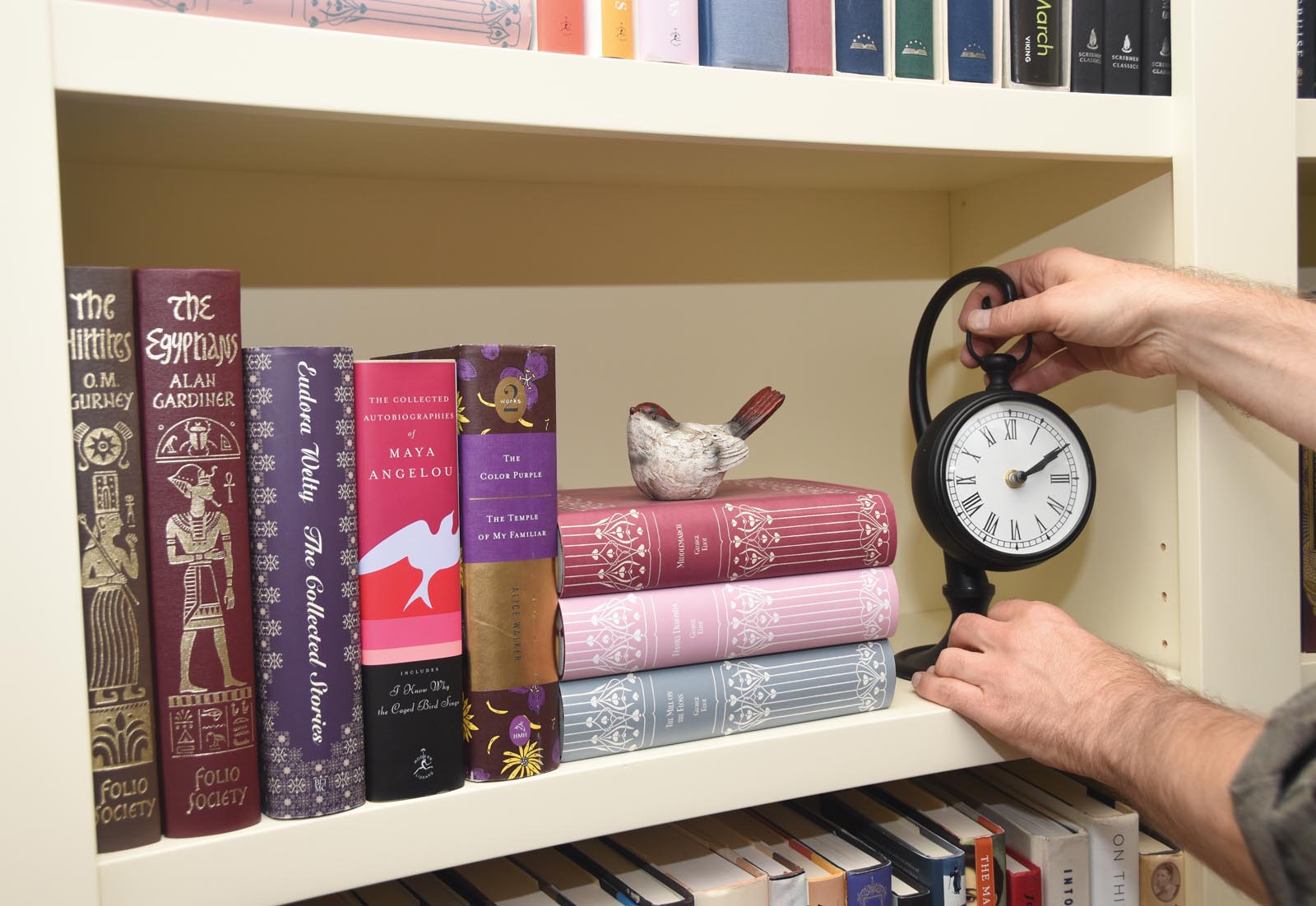
Look at your shelves as they are and perhaps take a picture for reference’s sake. As we did in the living room, do a quick scan of the size, color, and subject of each book. Take note of the actual shelves, their height and depth, the width, and how the shelves are grouped. Then think about the purpose of the room.

Next, take everything off the shelf so you are working with a blank slate. Give yourself this gift of a fresh start. Now that your books are gathered, start to organize them by subject—this helps to create a visual map of the books you have.
As you start to sort by genre—art, architecture, and travel for instance—you can then easily discern how much space is needed and their positioning, whether they should be stacked vertically spine to spine, placed in horizontal stacks, or perhaps a combination of both.

Slowly put the books back, playing with how they are arranged. This is the time to experiment a bit, find visual patterns by mixing spine colors, or playing with subject-oriented shelves to find the best movement. This eye toward fluidity makes the books more visually pleasing, inviting the viewer to follow a linear flow and discover new books while feeling relaxed in the space. Play with placing objects on the shelves surrounding your books, offering yet another piece to the story.
This first phase is really a time to experiment, nothing is written in stone. It’s a time to play and find which modes of organization are most appealing to you and work best for your space.

Sometimes a book you love goes on the shelf and it dominates the entire look. Don’t worry, the book doesn’t need to go, it just needs to go somewhere else. Elizabeth had a hardcover copy of Roald Dahl’s Book of Ghost Stories at the end of a shelf, and the front cover is a rather creepy large-scale photo of the author. Every time Elizabeth would walk in the living room, all she would see was Roald Dahl staring back at her. So she moved the book to the middle of a shelf, spine out. Problem solved. The spine was pretty benign and blended in beautifully with other books.

Experimenting with a variety of horizontal and vertical book stackings instantly breathes life and movement into the shelves and also serves as an easy way to highlight objects within the mix, while still using the maximum amount of space. It’s also a great solution for taller books that you would still like to feature on standard-sized shelves.

You’ve played a bit with objects in Step Three, and probably have an idea of which ones enhance the story of your books. As you inch toward a completed shelf, consider the placement of these accessories. Stack books as a horizontal support for your objects or use one to prop your books into position. Be careful that the books aren’t too heavy and won’t push the object over, causing something beloved to fall and break.

Placing books with attractive front covers with their front facing out brings an element of surprise to the shelf. Booksellers often do this with new releases to draw a customer’s attention, and there is no reason to not bring this tip home! Sometimes Thatcher places front facing books at the back of the bookcase so they are resting against the wall and other times, if the book is nice and solid, it can be placed at the front. Play with the depth and see what you prefer. Overall, we prefer all the books at the front edge of the bookcase—maybe half an inch from the front—but again, it is simply a preference.

Authors, images, subjects, colors. . . . As we mentioned above, there are myriad ways to organize your books and you can try multiple systems within your shelves. Group similar authors together and then continue to fill the space with similar subject matter, or see if your eye feels more relaxed sorting by color. Maybe you separate fiction and nonfiction, or find that they go better mixed together by subject matter—your Martin Walker mysteries fitting perfectly beside Peter Mayle’s musings on Provence. The options are endless and entirely personal.

An old phone, a crystal . . . anything might work. Perhaps you have an antique clock that can go on your shelf beside your beloved copy of A Wrinkle in Time or a seated Buddha statue next to your copy of Jack Kerouac’s The Dharma Bums.

See if some books look better without their jackets; you can always store the jacket separately and reunite it with the book at a later date. With rare books, the original dust jacket is often a key part of the value, and so sometimes it is a good idea to take the jacket off and store it safely, while also making sense from a design standpoint for your space.

Sometimes mixing antique and modern works well, sometimes it doesn’t. The minute the right book goes in the wrong spot, you will feel the shift instantly. Just set that book aside, another spot will appear as you continue to style the shelves.

As you work, continue to step back to perceive the whole. Sometimes things that seem to work up close don’t work so well from a distance. To save some time and avoid having to change entire shelves, keep stepping back to gain perspective.

Play with shades of color and try interspersing a different tone between two similar shades to break up the continuity and provide a surprise for the eye. Color coding that isn’t too spot-on is often an elegant approach.

Sometimes it takes a while, and different combinations, for the shelves to start to feel right.
When you find the right mix, the shelves will have character that reflect who you are and they will really feel like they belong in your home.

